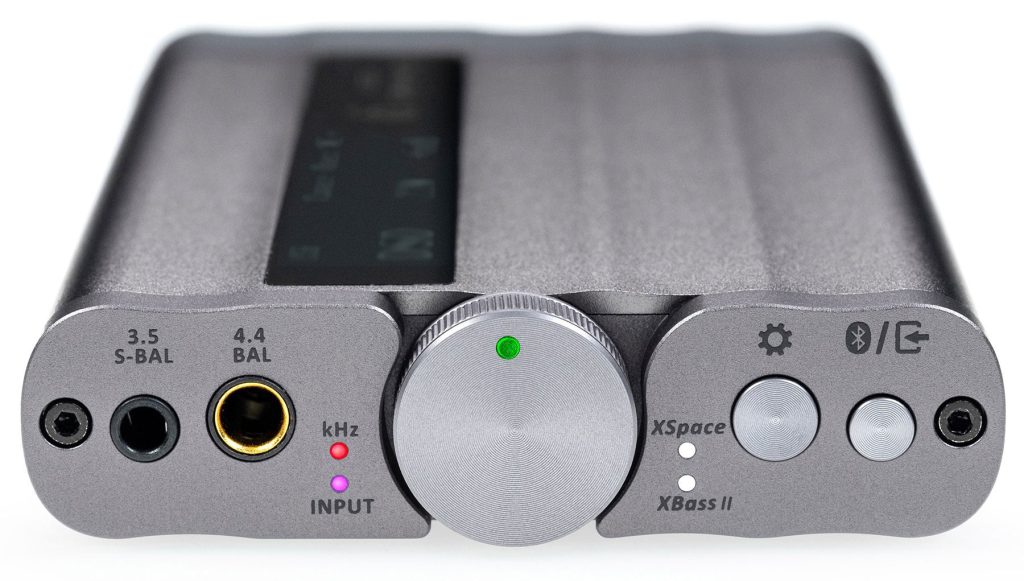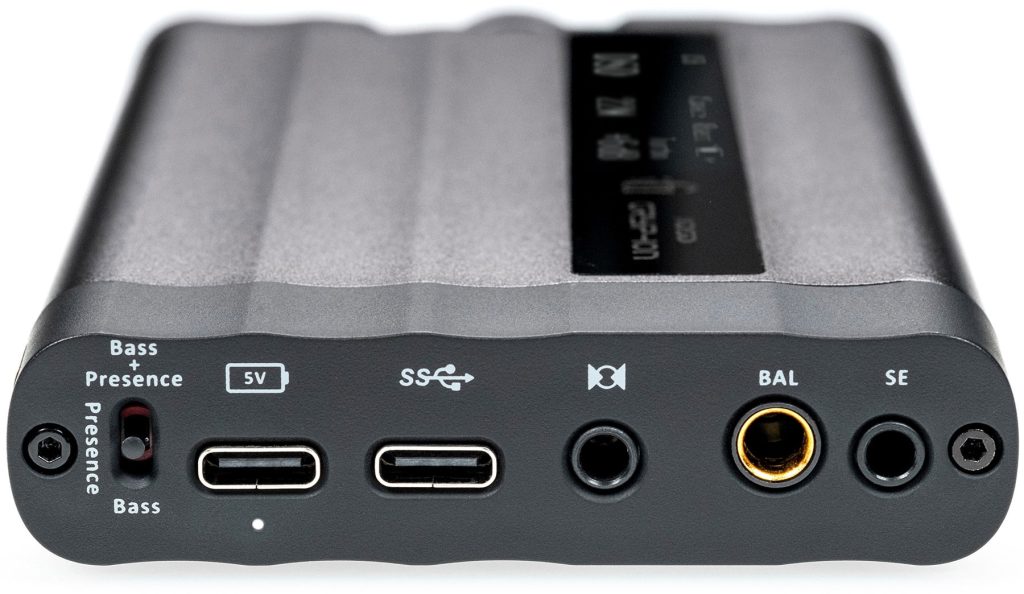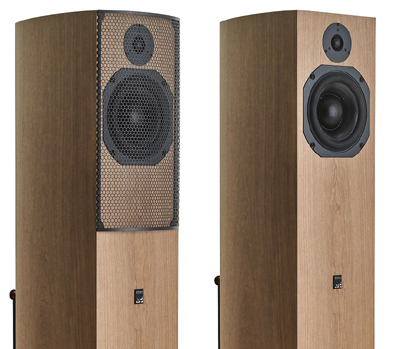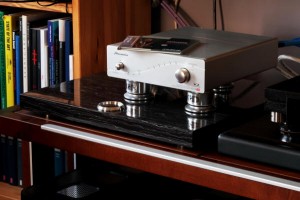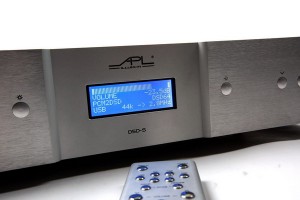iFi Audio has been on my radar for a couple of years mainly due to the excellent reviews for their affordable DACs, streamers, amps, and other digital accessories. The digital portion of my home audio system is currently in a transition phase. I had to give up my reference AURALIC Vega DAC, reviewed in Positive Feedback HERE, a few years ago and I haven't been able to decide what to get next while the technology has been changing rapidly. I decided to buy the $129 iFi Zen DAC as an interim solution so I could listen to my digital music while surveying the field. When the xDSD Gryphon was offered up for review I raised my hand based on the positive experience I'm having with the Zen. More on that later.
The xDSD Gryphon is a portable DAC/amplifier for headphone listening, using very sophisticated digital and analog engineering and high-quality parts in an affordable package. It lists for $599. Like most iFi products it is rich in features. First, on USB it plays back PCM files up to 768kHz, DSD up to 512kHz, DXD up to 768kHz, and decodes MQA. On S/PDIF it handles PCM up to 192kHz and DSD over PCM. It has all the latest Bluetooth connectivity including aptX, aptX HD, aptX Adaptive, aptX LL, LDAC, LHDC/HWA, AAC, and SBC (whew!). It uses a Bit-Perfect DSD and DXD Burr-Brown chip set for native playback of the digital files. Amplifier circuits use a balanced architecture so the xDSD can accommodate both balanced and single-ended headphones. A feature called CyberSync provides a software-driven volume control that operates in the analog domain to maintain synchronization between the volume from the source device and the xDSD. A feature called XBassII enhances low frequencies without affecting the midrange, and XSPACE is a spatializer that addresses the portrayal of soundstage when using headphones. iEMatch is a feature to adjust volume levels to maximize dynamic range when using sensitive inner-ear monitors (IEM). The xDSD comes in a solid aluminum case about the size of an iPhone but thicker. It weighs about 0.5 lb. It comes inside a nice velvet sleeve, but the website says a custom case is now available separately. Several short adapter cables are provided to connect the xDSD to various phones and computers if Bluetooth is not available or desired.
I did not evaluate any of the Bluetooth capabilities of the xDSD Gryphon because I don't have much experience with those. I'm sure iFi gets the most out of Bluetooth as possible, as they have been working on it for a long time. I chose to evaluate this DAC/amp combination using a pair of moderately priced ear speakers I had on hand in keeping with the affordable price of the xDSD Gryphon: the Cardas 5813 IEMs and the ESS-RLM-713 dynamic closed back headphones. I also compared the xDSD Gryphon with my iFi Zen DAC. The xDSD has two USB ports on the back. One is used for charging and the other for digital data. I fully charged the device via the power USB port, and then let music play through it for over 20 hours for break in without listening. I failed to log battery life, which probably depends on volume level and impedance load, but the battery seemed to last quite a long time. All listening tests were done on battery power.
Time to talk about the sound. I started by comparing the sound from my MacBook Air laptop (Intel silicon) to the xDSD Gryphon. I played a short playlist I have stored on the computer with various types of musical samples. I used my Cardas EM 5813 IEMs that fit my ears especially well, and that I use most often when traveling. I used the Vox application running on the Mac for the (analog) playback. After going through the playlist this way, I used the Audio Midi setup function on the Mac to switch sound output to USB and with 32-bit 384 kHz digital stream. I connected the xDSD Gryphon to the Mac USB output using a short adapter cable that iFi supplies with the device. I adjusted playback levels by ear to match between the two listening modes. Auditioning the same playlist, the first thing that struck me was the increase in visceral impact of the music when using the xDSD Gryphon. While the playback via the Mac analog output seemed veiled, the music leapt out of the computer with the xDSD Gryphon in use. There were other improvements up and down the line with the xDSD Gryphon. Bass response was extended and tightened; the mid-bass power range was brought forward; the xDSD Gryphon portrayed the presence region as accurately as captured by the recording; and the high-end clarity, transparency, and realism were only limited by the performance of the IEMs. Similarly, the xDSD Gryphon provided broad imaging with layered depth and, when present in the recording, allowed individual instruments and voices to stand out and breathe. All contributed to musical realism and emotional involvement. One could use the xDSD Gryphon for background music playback, but then an opportunity to exploit the power of music to soothe or excite the soul would be lost. I can tell you that whenever I used the xDSD Gryphon it grabbed my full attention, and I felt the better for it.
After this initial listening experiment, I continued to look deeper into my playlists while assessing some of the ergonomic and musical features of the device. The xDSD Gryphon comes across as a high-quality product fully worth its price. The large multi-function knob on one side is easy and smooth to use, the OLED display on the "top" of the unit is easy to read and shows the audio format, sampling rate, volume, input mode, battery level, and whether XSpace/XBassII are engaged. The Settings and Input Selector buttons on the front are small for the fumble fingered among us, but good enough. I could never remember what the three LEDs on the front meant and the labels are too small for me to read, but that's not much to complain about and probably has no alternative. The bottom of the xDSD Gryphon has a slide switch to engage the iEMatch feature used to optimize playback level to various headphone impedances without compromising dynamic range.
XSpace is iFi's spatializer approach to broaden the soundstage that seems confined to between the ears when using headphones. Other DAC/amp companies have similar features on their offerings. It was easy to hear XSpace working, but I rarely felt the need for it and kept it mostly turned off. That's just my taste and others may feel differently. XSpace works so use it at will. XBassII is another circuit that adds more low-bass punch to the music. It is most useful with open-air type headphones that sometimes suffer from weak bass response. I found this feature to be too much when listening to my Cardas IEMs. I spent some time listening with the ESS-RLM-713 on-ear headphones that I really like for their comfort on my head and smooth frequency response (see Positive Feedback review HERE). With these cans, which are not open-backed, XBassII was enjoyable on some music with low bass and a welcome feature.
The xDSD Gryphon has three digital filter options, selected via the multi-function volume knob. These are Bit Perfect (no digital filtering), Gibbs Transient Optimized (GTO-upsampled to 384/352kHz, minimum filtering, no pre-ringing, minimum post-ringing), and Standard (modest filtering, modest pre- and post-ringing). I was not familiar with the GTO filter, so I did a little research on it. GTO is a type of digital filter that focuses on getting the transient response correct, considering how our ears actually work. The iFi version of this filter was developed in conjunction with the developers of MQA and is implemented via firmware in the digital processing chips within the xDSD Gryphon. You can read more about it in the iFi whitepaper HERE.
I spent a couple of hours cycling through the filters with various types of music and settled on the standard filter for most of my listening. This is also a matter of taste and the resolving capability of your headphones so you may make a different choice.
The last phase of my evaluation compared the xDSD Gryphon to the iFi Zen DAC that I use as the DAC for my main music system. For this review I decided to compare the two devices using my Cardas IEMs and did not insert the xDSD Gryphon into my main music system (although this should be possible using a balanced adapter cable that I have). The Zen DAC was only $129 when I purchased it last year but is now discontinued in favor of a new slightly more expensive ($189) version with a more capable digital engine and some improved parts. I selected the Zen DAC based on features (including the capability to decode MQA) and sterling reviews that seemed to place it at the top of the heap in the $100 price range. For my main system I have it tricked out with a special low-noise iFi power supply, Stein footers, judicious use of Blue Tack for vibration control, and using the balanced output.
The extra cost of the xDSD Gryphon over the Zen DAC is clearly warranted. The overall sound is more sophisticated and detailed. Bass is better defined and solid. The soundstage is wider and has more action compared to the Zen. Yet, music is dynamic and involving with both devices and the response through the midrange is similarly sweet and nuanced. I love both gadgets.
The xDSD Gryphon may not be the best portable digital music player in the world, but the music it does produce is mighty fine. iFi Audio has other more expensive players in their product line they probably consider better. But, for $599, the xDSD Gryphon gives you a well-built, feature rich, portable digital player that fits in your pocket and makes music sound glorious. You can't go wrong with that.
iFi xDSD Gryphon HD DAC + Amplifier
Retail: $599
AMR/iFi audio (USA)
105 Professional Pkwy, Ste 1502, Yorktown, VA 23693
1211 Park Ave, Ste 102, San Jose, CA 95126
800.799.IFIA (4342)




